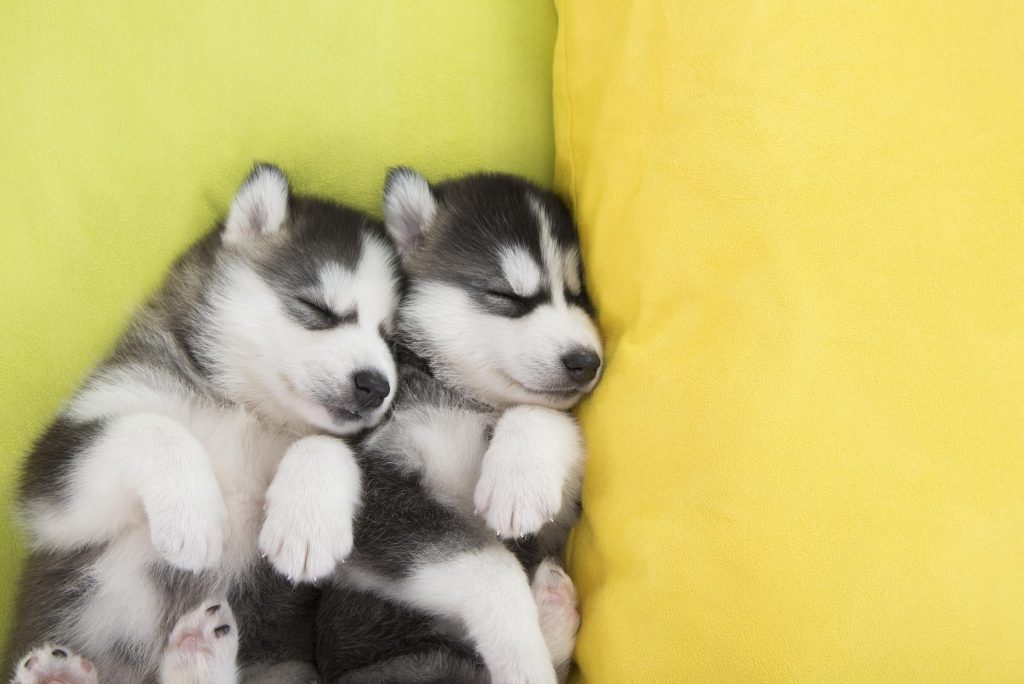
Siberian Huskies are working dogs and usually, they are medium-sized. They are well-known for their exceptional work ethic and amazing endurance. If you are preparing for your husky's breeding, which is one of the most important events for you and your dog, you should know how many puppies huskies have.
A Siberian Husky in good health will typically have between four and six puppies in a litter. However, this is not an exact number; sometimes a Husky may have fewer than four or more than six puppies in a litter. You can know the exact number for sure if you ask your vet to examine and estimate how many puppies your Husky is going to have.
Siberian Huskies have seven fertile years in their lifetime, and experts recommend not having more than four litters from a female husky. If a breeder is careful and waits about eighteen months between each breeding, a husky mama can give four litters during her lifetime.
Here's an example calculation that you can use to estimate.
If a husky is going to have six puppies as the highest number of puppies in a litter, it will have a maximum of 24 puppies in her lifetime.
Remember, if your husky is pregnant, you have to make sure to be gentle and try to keep her healthy.
A healthy diet helps a husky have healthy puppies. You can contact a vet to create a diet chart for your pregnant husky. Normally, huskies' gestation periods are around 63 days. After 45 days of your husky's pregnancy, you can arrange an X-ray and get a clear indication of how many puppies she is going to have.
When your husky's pregnancy period is at 4-5 weeks, you can feel her puppies. If you try to observe closely, you will be able to see the puppies move. And if you touch your husky's uterus area, you will be able to feel the movement of its puppies. This is amazing!
Normally, newborn huskies reach their adult size at 12 months, but they continue to grow until the second year. For some male huskies, it can take up to 36 months to reach their full size. Huskies continue to develop emotionally and intellectually until they are two years old. Your huskies are considered adult dogs if they are between one and seven years old; if they are seven years old, they are considered senior dogs.
Apart from these, there are some additional factors that can also affect the litter size of your husky.
When your adorable Husky pup romps around your living room, the last thing you might think about is her becoming a mother someday. But time flies, and before you know it, she has blossomed from a fluffy furball into a stunning, mature canine. This leads us to a question of prime importance: When exactly can your Husky become pregnant?
A Husky’s journey to potential motherhood begins around six months when she experiences her first heat cycle. But don't let those hormones fool you! Even though she can physically become pregnant at this age, she is still a pup herself. Rushing into motherhood can take a toll on her still-growing body and impact the health of the puppies.
Most breeders and vets recommend waiting until your Husky is at least two years old before considering breeding. By this age, she has not only reached physical maturity but also mental maturity, making her better equipped to handle the demands of pregnancy and raising a litter.
Remember, responsible breeding is not just about the timing; it's also about making sure your Husky is in optimal health. Conducting health tests, considering her genetic traits, and understanding the responsibilities of bringing a new litter into the world are all essential aspects of this process.
Have you ever wondered why one husky might have a litter of just two or three puppies, while another gives birth to a robust family of six or more? Believe it or not, the variation is not random. There's a fascinating blend of biology, genetics, and environmental factors at play. In the following section, we'll uncover the intriguing truths behind these litter size discrepancies and, in doing so, offer you a whole new understanding of your beloved pet. So, stick around. You don't want to miss this journey into the captivating world of canine genetics and breeding!
Imagine running a marathon, but instead of the race ending at 26.2 miles, the finish line is mysteriously changing places. Sounds exhausting, right? That's why knowing the exact pregnancy duration is vital, both for you and your Husky.
The typical pregnancy duration for Huskies, drumroll please, is about 63 days! Yes, it’s not as long as a human’s 9-month ordeal, but it's a journey, nonetheless. It's an incredible, joyous, and awe-inspiring trek to the miracle of life.
Now, think about the uncertainty lifted from your shoulders. No more guessing games, no more shifting finish lines. This consistent timeline helps you prepare for the D-day with a much-needed sense of clarity and calm.
But, just like in any marathon, there's always room for a little wiggle. Some Huskies may deliver a bit earlier or a tad later than the 63-day mark. But don't worry, it's completely normal and nothing to fret about.
Understanding your Husky's pregnancy duration opens up a new dimension in your relationship with your furry friend. It gives you an incredible opportunity to walk this journey alongside them, providing the necessary care and support they need during this crucial time.
Does the word 'hormones' ring a bell? Yes, those same infamous chemicals that are often blamed for everything from mood swings to overeating. But did you know they also play a leading role in your Husky's health and litter size?
Let's dive deeper, shall we? Hidden beneath the surface of your Husky's health are numerous hormones hard at work, with progesterone being one of the star performers. This pivotal hormone governs the reproductive cycle of dogs, guiding them through the various stages of pregnancy.
So, what happens when the star of the show, our dear friend progesterone, starts to falter? Simply put, low levels of this hormone can lead to smaller litters. It’s a vital cog in the machinery of reproduction, and its deficiency can impact your Husky's ability to have a large litter.
Therefore, maintaining balanced hormone levels is crucial for ensuring a healthy litter size. A Husky with well-regulated hormones is like a well-oiled machine, ready and primed for the miracle of life.
Remember, the journey of caring for your pregnant Husky is a pathway to a deeper understanding and appreciation of their biology and well-being. So, let's embrace the hormonal symphony, and ensure our husky companions are healthy, happy, and hormonally balanced.
We are about to unveil the secret ingredient of a healthy Husky litter – Progesterone. This hero hormone is the unsung powerhouse of your Husky's reproductive journey.
But, like any powerful force, its impact can swing both ways. High progesterone levels? Your Husky is on track for a large, healthy litter. Low progesterone levels? That could potentially mean a smaller litter size.
Understanding the nuances of progesterone in your Husky's health narrative is not just science – it's also art, empathy, and above all, the epitome of responsible pet ownership. So, let's decode the progesterone puzzle and ensure that your Husky is in the prime of health, ready to welcome a litter of playful pups.
Remember, keeping your readers engaged is all about presenting a mixture of valuable information, personal anecdotes, and a conversational tone. Always keep their curiosity piqued and their thirst for knowledge about their beloved Huskies quenched.
Isn't the expectancy of welcoming a new litter of Husky puppies a thrill? The anticipation, the guessing game! Yet, wouldn't it be wonderful if we could peek into the future, or in this case, into your furry friend's belly to know exactly how many little miracles are on their way?
Say no more; science has a solution!
However, even superheroes have their limitations. None of these methods are foolproof, as puppies can be elusive, hidden behind their siblings, or too petite to be noticed. So, the actual count may vary slightly from the initial estimate. Still, isn't this uncertainty part of the excitement?
Dive into the fascinating world of canine genetics and you'll encounter a puzzle as captivating as the Siberian Huskies themselves: their litter sizes. The magnificent Husky, known for its athletic prowess and larger-than-life persona, brings to the world litters that are, on average, relatively larger than many other breeds. But, how does this compare across the vast landscape of dog breeds?
Expect a litter size of anywhere between 4 to 6 puppies when it comes to Huskies. This range, while common, is just an average and can fluctuate widely depending on individual dogs and even within the same litter. The intrigue of nature's mystery adds to the thrill of the expectancy.
This abundance in the Husky litters isn't a surprise when we look at their physical attributes. Huskies, being larger and more muscular, are often able to carry more puppies. Their sturdy bodies and robust health contribute to this capacity, yet another testament to their strength.
However, larger litters don't come without their considerations. The wellness of the mother and her puppies takes precedence over the sheer numbers. More puppies can mean increased strain on the mother's health, and the risk of complications during pregnancy and delivery can escalate.
Embracing the arrival of a Husky litter is no less than an adventure. Each litter presents a beautiful enigma, reflecting the rich tapestry of life in the canine world. Remember, as prospective Husky parents or breeders, your role is crucial. Ensuring the mother's health and well-being can ensure the safe arrival of these joyous bundles of fur into the world. The experience will surely be a roller-coaster ride of emotions, and seeing those little ones flourish makes every moment worth it!
In our journey exploring Siberian Husky reproduction and puppy care, we've covered aspects from their unique traits to litter sizes and influencing factors. A healthy Husky can bear four to six puppies, although various factors like maternal health, sire breed, and maternal age can alter this. Husky puppies need proper care, nutrition, vaccinations, and socialization to grow into healthy adults. A Husky should ideally have no more than four litters in her lifetime to ensure responsible breeding. Being a responsible owner goes beyond just anticipating puppies – it entails the mother Husky's health, puppies' care, and understanding the lifetime commitment these dogs need. As you venture into this journey, remember that every puppy deserves love, care, and respect. Thank you for joining us in exploring Siberian Huskies. If you have questions or need guidance, consult a professional. Your husky's health and happiness are worth it!
On average, a first-time Husky mother can have around 4 to 6 puppies. However, the number can vary due to various factors such as genetics, health, and age.
A Husky's second litter can be larger, with about 4 to 8 puppies. But, this can depend on the mother's health, age, and genetics.
Huskies, like most dog breeds, have an average gestation period of approximately 63 days, but this can range between 58 to 68 days.
Yes, a Husky can have only one puppy, although this is less common. Such a situation is known as a singleton puppy.

Pet's Better Life is part of Pristine Media, the media division of Pristine Group LLC.
Copyright 2019-2023 Pristine Group LLC. All images and media used in this website are provided by Adobe Stock. Every image is properly licensed for use on this website.